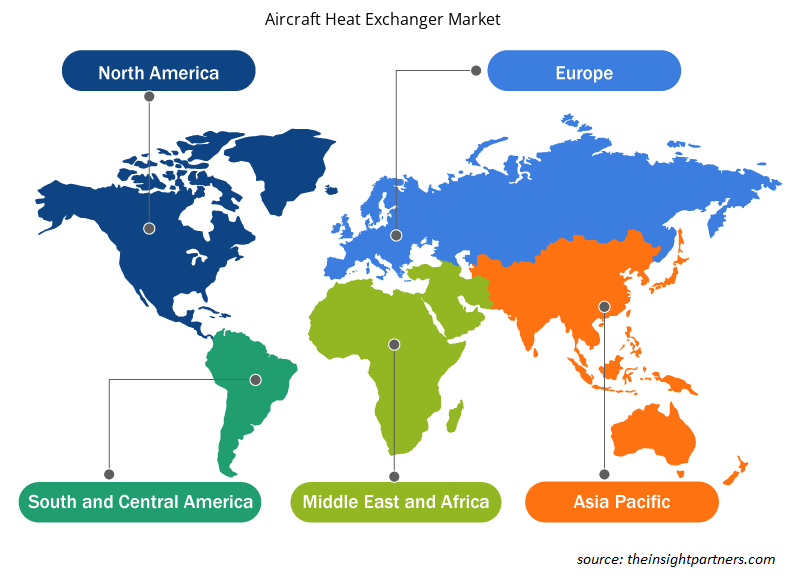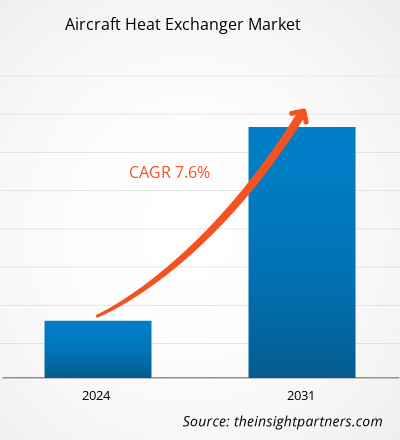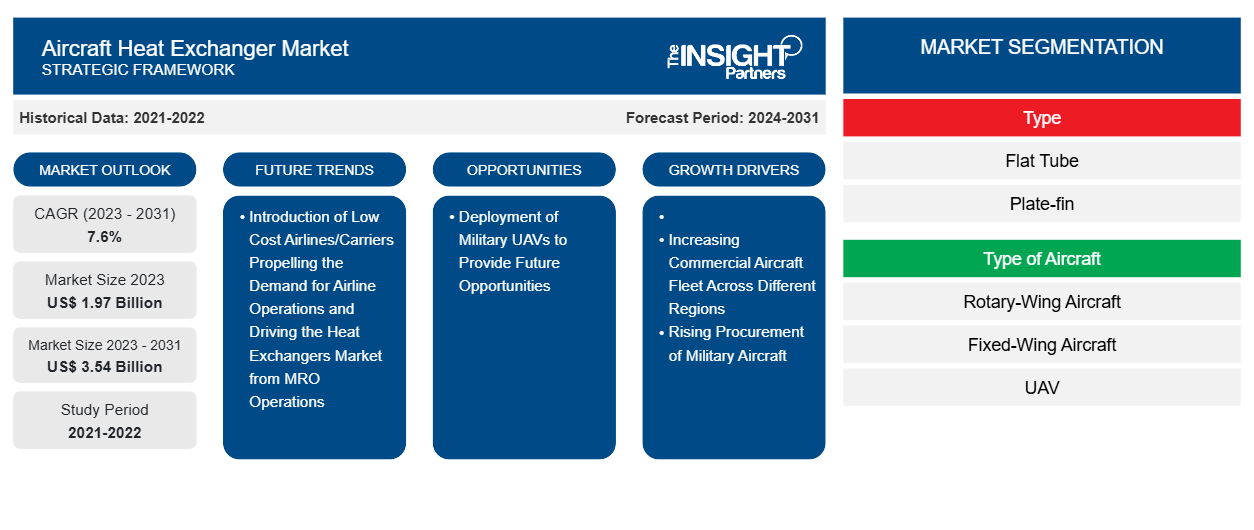Der Markt für Flugzeugwärmetauscher soll von 1,97 Milliarden US-Dollar im Jahr 2023 auf 3,54 Milliarden US-Dollar im Jahr 2031 anwachsen. Der Markt soll in den Jahren 2023–2031 eine durchschnittliche jährliche Wachstumsrate von 7,6 % verzeichnen. Die globale Flugzeugbauindustrie verfügt über eine große Anzahl etablierter Unternehmen auf der ganzen Welt, deren Verhandlungsmacht in den kommenden Jahren voraussichtlich stark ansteigen wird. Aufgrund der Präsenz einer großen Anzahl von Wärmetauscherlieferanten auf dem Markt haben die Flugzeughersteller mehrere Möglichkeiten, den besten Hersteller auszuwählen, der qualitativ hochwertigere Produkte, besseren Kundenservice und niedrigere Preise bietet.
Marktanalyse für Wärmetauscher für Flugzeuge
Die Nachfrage nach Flugzeugwärmetauschern steigt bei Flugzeugherstellern und Fluggesellschaften. Die Designer von Flugzeugwärmetauschern investieren enorme Summen in die Entwicklung fortschrittlicher Technologien wie additive Fertigung, um den Designprozess zu vereinfachen. Dieser Faktor zieht die Kunden von Wärmetauscherdesignern, -herstellern und -lieferanten an. Die Fluggesellschaften beziehen den Flugzeugwärmetauscher über OEMs. Auch Flugzeughersteller wie Boeing und Airbus überzeugen ihre Kunden, neue Flugzeuge mit fortschrittlichen Produkten auszustatten. Dies trägt ebenfalls zum Wachstum des Flugzeugwärmetauschermarktes bei.
Marktübersicht für Flugzeug-Wärmetauscher
Der Markt für Flugzeugwärmetauscher dürfte in den kommenden Jahren ein starkes Wachstum verzeichnen. Das Marktwachstum ist auf einige der folgenden Faktoren zurückzuführen:
- Ausbau der kommerziellen Flugzeugflotte in verschiedenen Regionen
- Steigende Beschaffung von Militärflugzeugen
- Neuer Bedarf an effektiver Kühlung und Heizung in Verkehrsflugzeugen zur Verbesserung des Flugbetriebs
Diese Faktoren werden sich wahrscheinlich erheblich auf das positive Wachstum des Marktes für Flugzeugwärmetauscher auswirken. Der Bedarf an effektivem Wärme- und Kältemanagement ist ein weiterer wichtiger Faktor, der die Nachfrage nach der Installation von Wärmetauschern in neuen Flugzeugen und in der bestehenden Flugzeugflotte verschiedener kommerzieller Fluggesellschaften erzeugt. Darüber hinaus ist die steigende Beschaffung und Bestellung von Militärflugzeugen ein weiterer wichtiger Faktor, der die Einführung von Wärmetauschern auch für Militärflugzeuge beschleunigt.
Passen Sie diesen Bericht Ihren Anforderungen an
Sie erhalten kostenlose Anpassungen an jedem Bericht, einschließlich Teilen dieses Berichts oder einer Analyse auf Länderebene, eines Excel-Datenpakets sowie tolle Angebote und Rabatte für Start-ups und Universitäten.
-
Holen Sie sich die wichtigsten Markttrends aus diesem Bericht.Dieses KOSTENLOSE Beispiel umfasst eine Datenanalyse von Markttrends bis hin zu Schätzungen und Prognosen.
Treiber und Chancen auf dem Markt für Flugzeug-Wärmetauscher
Ausbau der kommerziellen Flugzeugflotte in verschiedenen Regionen
Die steigende Nachfrage der Fluggesellschaften in verschiedenen Regionen nach neuen Flugzeugen ist einer der Hauptfaktoren, die die globale Flugzeugflottengröße antreiben. Im Jahr 2023 betrug die weltweite Flottengröße für Verkehrsflugzeuge etwa 27.385 Flugzeuge und stieg 2024 auf 28.398 Verkehrsflugzeuge. Dieser Flottenzuwachs hat die Nachfrage nach Flugzeugwärmetauschern in verschiedenen Regionen angetrieben. Darüber hinaus werden die bevorstehenden Auslieferungen gemäß den Angaben von Airbus und Boeing (d. h. zwischen 2023 und 2042 werden voraussichtlich mehr als 40.000 Flugzeuge ausgeliefert) den Markt für Flugzeugwärmetauscher in den kommenden Jahren wahrscheinlich ebenfalls ankurbeln.
Einsatz militärischer Drohnen als Chance für die Zukunft
Die steigende Zahl von UAV- Einsätzen bei den Streitkräften verschiedener Länder ist einer der Hauptfaktoren, die wahrscheinlich neue Möglichkeiten für neue Installationen von Wärmetauschern im UAV-Segment schaffen werden. Darüber hinaus wird dies auch durch die steigenden Militärausgaben in verschiedenen Ländern weltweit unterstützt, die mehr Geld für die Beschaffung militärischer UAVs ausgeben. Solche Faktoren werden in den kommenden Jahren wahrscheinlich neue Möglichkeiten für den Markt für Flugzeugwärmetauscher schaffen.
Segmentierungsanalyse des Marktberichts für Wärmetauscher für Flugzeuge
Wichtige Segmente, die zur Ableitung der Marktanalyse für Flugzeug-Wärmetauscher beigetragen haben, sind Typ, Flugzeugtyp, Anwendung, Herstellungsart und Geografie.
- Basierend auf dem Typ wurde der Markt in Flachrohr und Lamellen unterteilt. Das Lamellensegment hatte im Jahr 2023 einen größeren Marktanteil.
- Nach Flugzeugtyp wurde der Markt in Starrflügelflugzeuge, Drehflügler und UAVs segmentiert. Das Segment der Starrflügelflugzeuge hatte im Jahr 2023 den größten Marktanteil.
- In Bezug auf die Anwendung wurde der Markt in Triebwerke und Flugzeugzellen segmentiert. Das Triebwerkssegment dominierte den Markt im Jahr 2023.
- In Bezug auf die Art der Herstellung wurde der Markt in konventionelle und additive Fertigungsarten segmentiert. Das Segment der konventionellen Art dominierte den Markt im Jahr 2023.
Marktanteilsanalyse für Flugzeug-Wärmetauscher nach Geografie
Der geografische Umfang des Marktberichts für Flugzeugwärmetauscher ist hauptsächlich in fünf Regionen unterteilt: Nordamerika, Europa, Asien-Pazifik, Naher Osten und Afrika sowie Südamerika.
Nordamerika dominierte den Markt für Flugzeugwärmetauscher im Jahr 2023, während die Region Asien-Pazifik im Prognosezeitraum wahrscheinlich ein deutliches Wachstum verzeichnen wird. Die Region Nordamerika umfasst die USA, Kanada und Mexiko. Die USA dominierten den nordamerikanischen Markt für Flugzeugwärmetauscher im Jahr 2023. Dies ist hauptsächlich auf den steigenden Fluggastverkehr und die zunehmende Flugzeugflotte im ganzen Land zurückzuführen. Darüber hinaus werden die zukünftigen Flugzeugauslieferungen in den kommenden zwanzig Jahren auch neue Möglichkeiten für die Marktanbieter in der Region Nordamerika schaffen. Laut dem Airbus Global Market Forecast-Bericht werden beispielsweise zwischen 2023 und 2042 voraussichtlich mehr als 6.970 Verkehrsflugzeuge ausgeliefert. Dies wird in den kommenden Jahren eine neue Nachfrage nach Flugzeugwärmetauschern erzeugen.
Regionale Einblicke in den Flugzeugwärmetauschermarkt
Die regionalen Trends und Faktoren, die den Markt für Flugzeugwärmetauscher im Prognosezeitraum beeinflussen, wurden von den Analysten von Insight Partners ausführlich erläutert. In diesem Abschnitt werden auch die Marktsegmente und die Geografie von Flugzeugwärmetauschern in Nordamerika, Europa, im asiatisch-pazifischen Raum, im Nahen Osten und Afrika sowie in Süd- und Mittelamerika erörtert.

- Erhalten Sie regionale Daten zum Flugzeug-Wärmetauschermarkt
Umfang des Marktberichts über Wärmetauscher für Flugzeuge
| Berichtsattribut | Details |
|---|---|
| Marktgröße im Jahr 2023 | 1,97 Milliarden US-Dollar |
| Marktgröße bis 2031 | 3,54 Milliarden US-Dollar |
| Globale CAGR (2023 - 2031) | 7,6 % |
| Historische Daten | 2021-2022 |
| Prognosezeitraum | 2024–2031 |
| Abgedeckte Segmente |
Nach Typ
|
| Abgedeckte Regionen und Länder |
Nordamerika
|
| Marktführer und wichtige Unternehmensprofile |
|
Dichte der Marktteilnehmer für Wärmetauscher für Flugzeuge: Die Auswirkungen auf die Geschäftsdynamik verstehen
Der Markt für Flugzeug-Wärmetauscher wächst rasant, angetrieben durch die steigende Nachfrage der Endnutzer aufgrund von Faktoren wie sich entwickelnden Verbraucherpräferenzen, technologischen Fortschritten und einem größeren Bewusstsein für die Vorteile des Produkts. Mit steigender Nachfrage erweitern Unternehmen ihr Angebot, entwickeln Innovationen, um die Bedürfnisse der Verbraucher zu erfüllen, und nutzen neue Trends, was das Marktwachstum weiter ankurbelt.
Die Marktteilnehmerdichte bezieht sich auf die Verteilung von Firmen oder Unternehmen, die in einem bestimmten Markt oder einer bestimmten Branche tätig sind. Sie gibt an, wie viele Wettbewerber (Marktteilnehmer) in einem bestimmten Marktraum im Verhältnis zu seiner Größe oder seinem gesamten Marktwert präsent sind.
Die wichtigsten auf dem Markt für Flugzeug-Wärmetauscher tätigen Unternehmen sind:
- Boyd Corporation
- Collins Luft- und Raumfahrt
- Honeywell International Inc.
- Jamco Corporation
- Firmengruppe Liebherr
- Meggitt PLC
Haftungsausschluss : Die oben aufgeführten Unternehmen sind nicht in einer bestimmten Reihenfolge aufgeführt.

- Überblick über die wichtigsten Akteure auf dem Markt für Flugzeug-Wärmetauscher
Nachrichten und aktuelle Entwicklungen zum Flugzeug-Wärmetauschermarkt
Der Markt für Flugzeugwärmetauscher wird durch die Erfassung qualitativer und quantitativer Daten nach Primär- und Sekundärforschung bewertet, die wichtige Unternehmensveröffentlichungen, Verbandsdaten und Datenbanken umfasst. Im Folgenden finden Sie eine Liste der Entwicklungen auf dem Markt für Flugzeugwärmetauscher und Strategien:
- Im Juni 2023 stellte Safran Aero Boosters auf der Paris Air Show HIPEX vor, eine neue Reihe von Hochleistungswärmetauschern, die auf einem revolutionären aerodynamischen Design basieren. (Quelle: Safran Group, Pressemitteilung/Unternehmenswebsite/Newsletter)
- Im Mai 2023 hat AMETEK MRO AEM, ein führender Anbieter von Wartungs-, Reparatur- und Überholungsdiensten (MRO) für Flugzeuge, seine Wärmetauscherkapazitäten in seinem Werk in Ramsgate im Vereinigten Königreich erweitert. (Quelle: AMETEK, Pressemitteilung/Unternehmenswebsite/Newsletter)
Marktbericht zu Wärmetauschern für Flugzeuge – Umfang und Ergebnisse
Der Bericht „Marktgröße und Prognose für Wärmetauscher in Flugzeugen (2021–2031)“ bietet eine detaillierte Analyse des Marktes, die die folgenden Bereiche abdeckt:
- Marktgröße und Prognose auf globaler, regionaler und Länderebene für alle wichtigen Marktsegmente, die im Rahmen des Projekts abgedeckt sind
- Marktdynamik wie Treiber, Beschränkungen und wichtige Chancen
- Wichtige Zukunftstrends
- Detaillierte Porter's Five Forces Analyse
- Globale und regionale Marktanalyse mit wichtigen Markttrends, wichtigen Akteuren, Vorschriften und aktuellen Marktentwicklungen
- Branchenlandschaft und Wettbewerbsanalyse, einschließlich Marktkonzentration, Heatmap-Analyse, prominenten Akteuren und aktuellen Entwicklungen
- Detaillierte Firmenprofile mit SWOT-Analyse
- Historische Analyse (2 Jahre), Basisjahr, Prognose (7 Jahre) mit CAGR
- PEST- und SWOT-Analyse
- Marktgröße Wert/Volumen – Global, Regional, Land
- Branchen- und Wettbewerbslandschaft
- Excel-Datensatz
Aktuelle Berichte
Verwandte Berichte
Erfahrungsberichte
Grund zum Kauf
- Fundierte Entscheidungsfindung
- Marktdynamik verstehen
- Wettbewerbsanalyse
- Kundeneinblicke
- Marktprognosen
- Risikominimierung
- Strategische Planung
- Investitionsbegründung
- Identifizierung neuer Märkte
- Verbesserung von Marketingstrategien
- Steigerung der Betriebseffizienz
- Anpassung an regulatorische Trends























 Kostenlose Probe anfordern für - Markt für Flugzeugwärmetauscher
Kostenlose Probe anfordern für - Markt für Flugzeugwärmetauscher